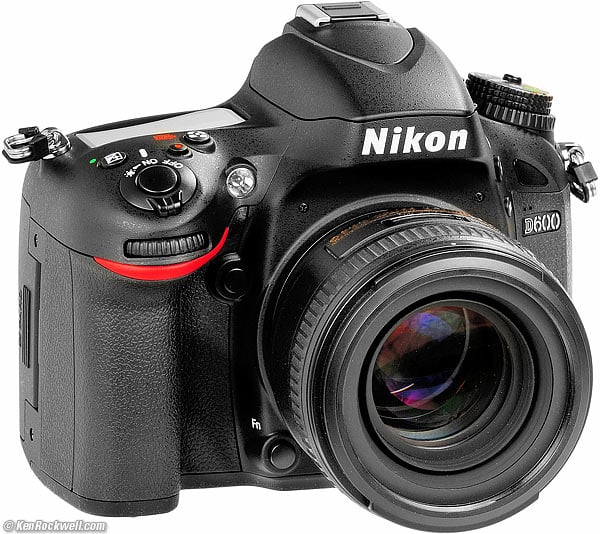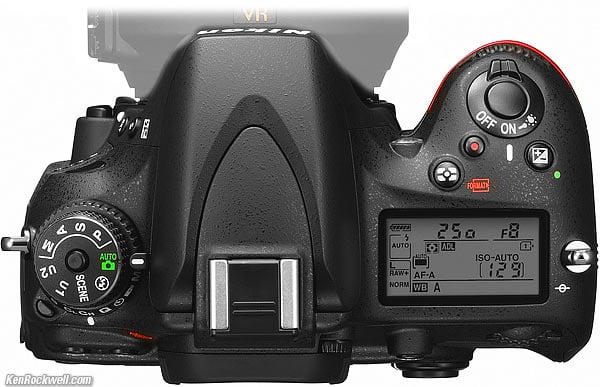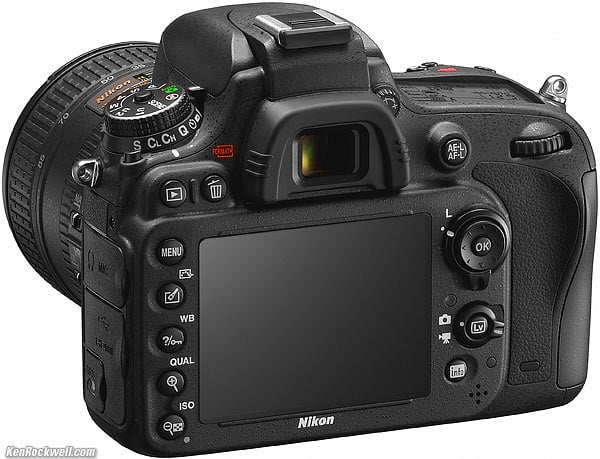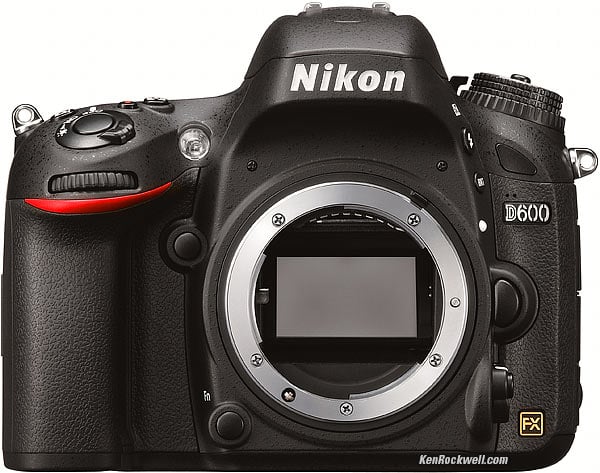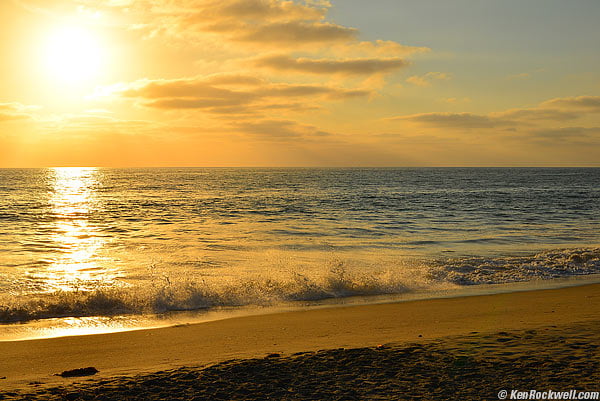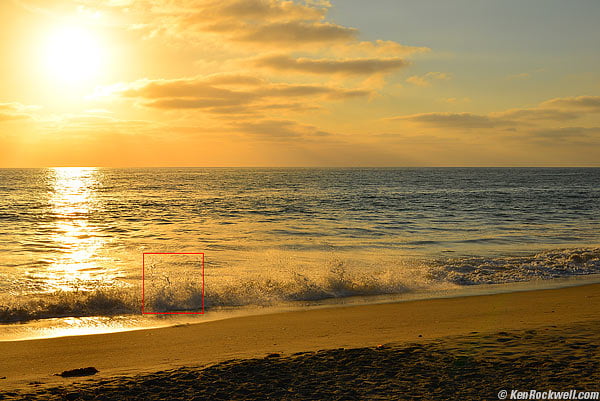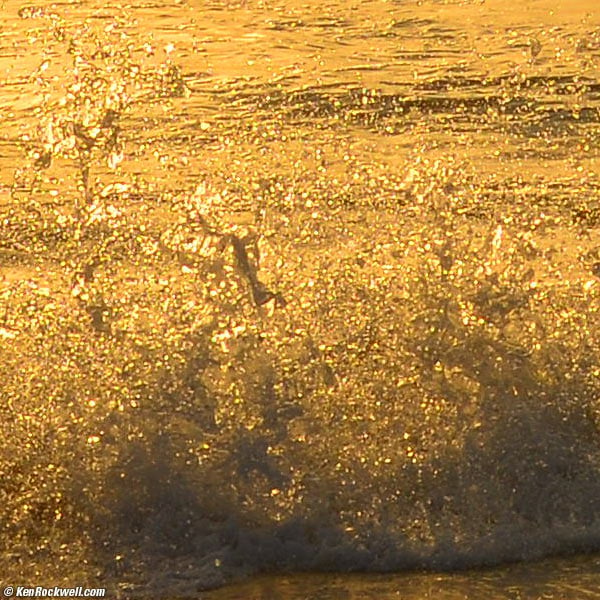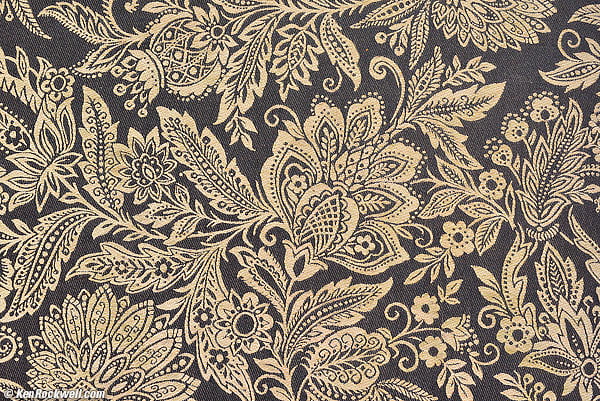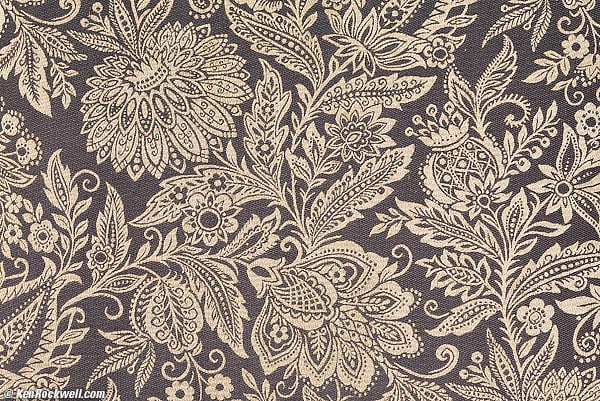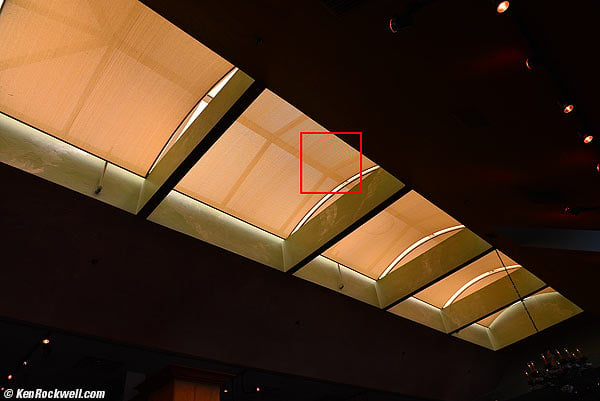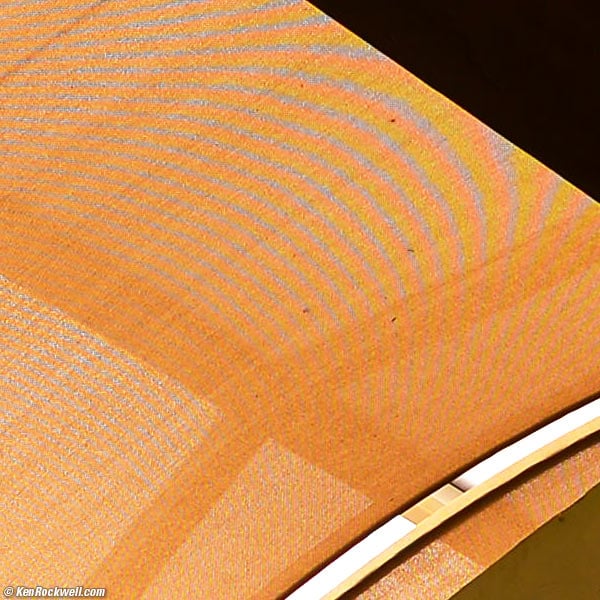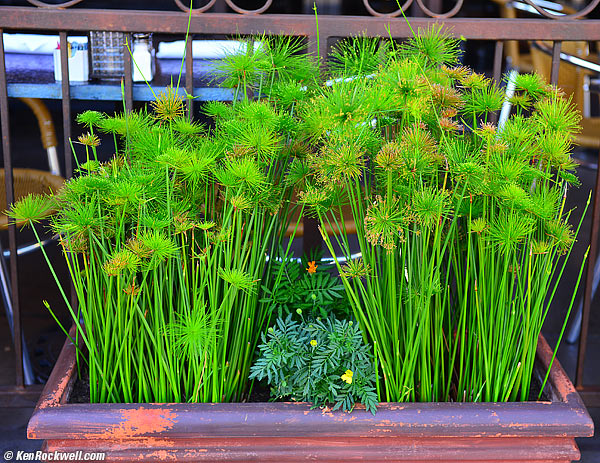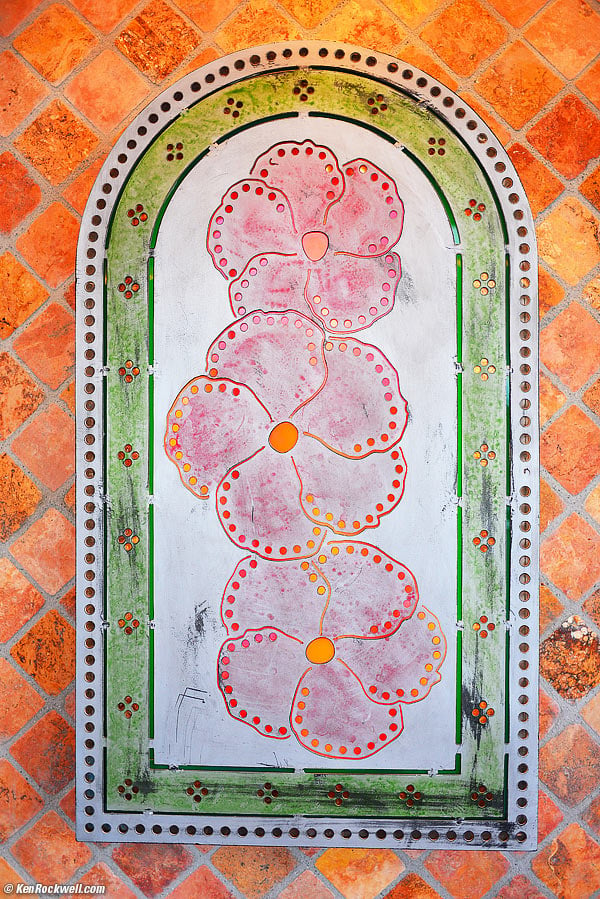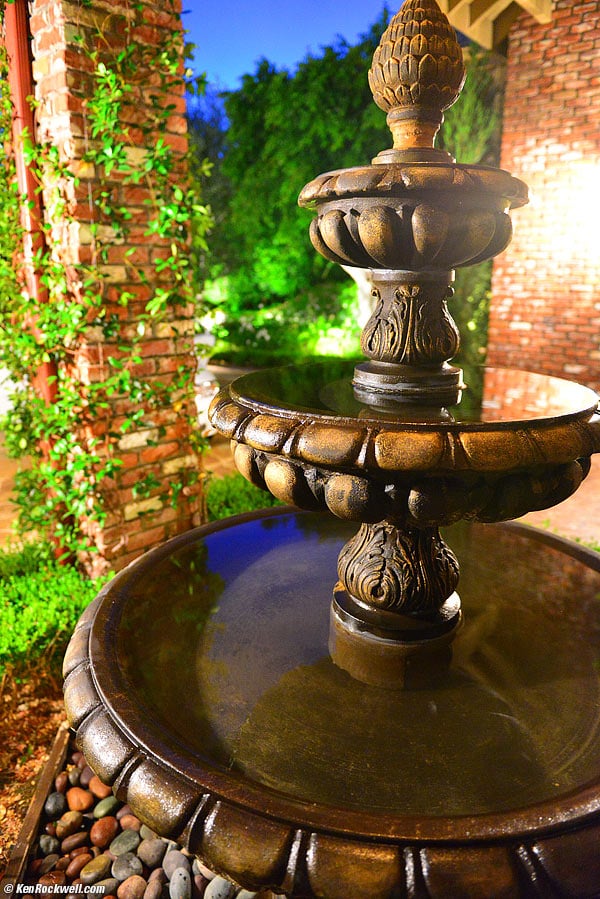Home Donate New Search Gallery Reviews How-To Books Links Workshops About Contact
Nikon D600
24 MP FX, 5.5 FPS, 2-SD cards
© 2014 KenRockwell.com. All rights reserved.
Introduction Lenses Missing Specifications Accessories
Performance Compared Usage Recommendations More
Nikon D600 (30.0 oz./850 g with battery and card, $2,000 new with 24-85mm lens or about $1,500 used, body only) and 50mm f/1.4 G. enlarge. My biggest source of support is when you use those or these links when you get anything, regardless of the country in which you live. I receive nothing for my efforts if you take the chance of buying elsewhere. Thank you! Ken.
July 2014 More Nikon Reviews Nikon Lenses All Reviews
NEW: Nikon D810, D800E, D600 and D3 Sharpness Comparison. 30 July 2014
NEW: Nikon D610. The same thing, with a slightly different shutter.
LEICA M240, LEICA M9, Fuji X100S and Nikon D600 Image Quality Comparison 11 March 2014
Free New Shutters!
My D600 is fine, but Nikon is offering to replace any D600 shutters for free if you think there's a dirt or oil problem. Here's how to send yours in.
Since mine has always been fine, I don't know that I'll bother.
Nikon D600, D7100 and D7000 Image-Quality Comparison 10 April 2013
The D600, D800 and D4 are the same camera inside! 22 October 2012
Nikon D600 versus D800 15 September 2012
Nikon D600 versus D700 15 September 2012
Nikon D600 versus D7000 15 September 2012
2012 Full-Frame DSLR Comparison Table
Back, Nikon D600. enlarge.
Top, Nikon D600. enlarge.
Rear, Nikon D600. enlarge.
Introduction top
Introduction Lenses Missing Specifications Accessories
Performance Compared Usage Recommendations More
The Nikon D600 is Nikon's best digital camera ever, at any price.
The D600 has better image quality than any of Nikon's professional cameras like the $6,000 D4, and the D600 is the smallest and lightest full-frame digital camera ever from Nikon. The D600 has the best ergonomics and handling of any Nikon DSLR.
Another great thing about the D600 is it seems to be the first Nikon DSLR that always gets the exposure and auto white balance (AWB) correct. I rarely, if ever need to add any exposure compensation or tweak AWB regardless of conditions. See my snaps of Katie and of Ryan; there are pretty much all shot in U2 without any more tweaks needed from my personal default settings This is a major step forward; pixel count has been irrelevant for years.
For feature counters, the D600 has 1080p HD video, built-in HDR, an electronic horizon and more.
Like most Nikon DSLRs, the D600 automatically corrects for any lateral color fringes in any lens, and for just about all Nikon lenses introduced in the past 20 years (any AF-D, AF-I, AF-S or G lens), also can automatically correct for lens distortion and corner light falloff. While it won't correct distortion with Nikon AI and AI-s manual focus lenses, it does provide full color Matrix metering, EXIF data and auto and manual exposure. Got a set of Nikon lenses from 30 years ago? You're already good to go with the D600; they'll look great.
The Nikon D600 is very quiet and refined. The D600 is a little quieter than the D800, and much quieter than the D4. All have "Quiet" modes, but none work very well.
The D4 runs faster and is the choice of full-time sports and action pros, but it has slightly less resolution than the D600. In practice, D4 images are almost as good, but the D4 is too heavy and lacks the critical U1 and U2 modes of the D600 that I find so critical to my day-to-day use.
The Nikon D600 is the camera we really wanted when Nikon announced the D800. The D600 is the mostly same thing as the D800, packed into the smaller body with the improved ergonomics of the D7000, giving us the best of both worlds! With the addition of the U1 and U2 modes originally introduced with the D7000, we can set and reset the D600 to whatever we're shooting quickly — and even better than the D7000, the dial now locks.
The D600 is essentially a bored-and-stroked D7000 (a bigger sensor, reflex mirror and finder crammed into a D7000 body), and the D7000 has been ergonomically Nikon's best digital camera ever made. Now in the D600 we have the ergonomic élan of the D7000, with the state-of-the-art full-frame image power of the D3X or D800.
The D800 and D800E have too many pixels, and they also have crappy ergonomics compared to the D600. The D800s are preferred by pixel-counting computer hobbyists, but their files are so big that they gum up most normal people's computers, and sometimes their huge files won't print properly at some printing kiosks unless made smaller in a computer. Most importantly to me, the D800s also lack the critical U1 and U2 modes of the D600 that I find so critical to my day-to-day use — and the D800s still cost much more and weigh too much as well. Unless you actually print your work, and print often at 40 x 60" (1 x 1.5 meters) and larger, there's no reason for the D800 and D800E. iPad screens only have a couple of megapixels, and showing your work online, images have less than one megapixel. No one needs 36 MP; it's just a marketing feature.
The D600's 24 MP is more than twice as much as anyone needs for anything. I'd be happy with only 10 MP in full-frame if it had the great U1 and U2 instant recall modes of the D600; utility is the difference between getting the picture and missing it; resolution today is so high it doesn't matter anymore, and some cameras like the D800 have such excessive marketing-driven resolution that the files bog everything down.
Whenever anyone packs this much large-format image quality into such a small package, I'm all over it! The D600's 24MP is enough for astounding mural-sized images without size limits if your lenses and technique are good enough, and the D600 is small and compact. 24 MP is astounding if you know what you're doing. If you do, mural-sized prints look spectacular.
Don't let the D600's small size and light weight fool you: the D600 is much faster than the D800: 5.5 FPS versus only 4 FPS! The D600 keeps cranking as fast as I ever need it to, and never, ever chokes on its 24 MP files, either.
The Nikon D600 was the world's smallest, lightest and least expensive full-frame DSLR until Canon announced the Canon 6D four days later at the same price, with even less weight.
The only bad thing about the D600 is that it has the same green color shift problem of the D800 and D4. The LCDs aren't that bad; the problem is that the actual images are often a tad too green! I dial-in M1 (extra magenta) in the auto white balance to get rid of the excess green.
Considering that the much more expensive D800 and D4 have exactly this same problem, I'm not going to whine about it in the D600. I set:
MENU > SHOOTING > White Balance > AUTO > right click to AUTO Normal > right click to the rainbow chart > click one down to M1 > OK
and the green goes away.
Seeing how all of Nikon's 2012 FX cameras have the same flaw, it's as if Nikon is deliberately dumbing-down the color accuracy across the board so all the cameras match, and also so when we finally get used to it, the next wave of cameras can feature "greatly improved color accuracy!" In Japan, it's always two forward, one back. No worries, set that M1 trick and the colors are fine.
I'm very, very happy; I didn't think Nikon would ever actually release the D600, which is an improved, lighter-weight version of the D800 for less money than any full-frame Nikon digital ever.
The Sensor Dust Rumor
My D600's sensor is clean.
I wouldn't worry about what you may have read over the Internet from people you've never met. These things always happen for every new camera: one guy of many sees it, and the Internet spreads it like wildfire.
See My New Product Reliability article for more on this phenomenon. People spread these things all over, and they greatly multiply themselves over the Internet.
My D600 is fine, and if it weren't, Nikon would fix it under warranty.
It doesn't bother me, but I'm astounded at how many impressionable people have gotten all terrified of this not because they've ever seen the problem, but because they read it somewhere as posted by some stranger.
I do know a guy personally who claims that his D600 had some dirt, and Nikon fixed it for him for free, fast. Big deal.
Want to know which camera really has a dirt problem? My D3; it has no built-in cleaner and it's filthy after five years of heavy use.
My D600's sensor is super clean. See more at New Product Reliability if you're concerned. I've seen this uncommon-problems-getting-blown-out-of-proportion issue many times since the Internet became popular, but never seen any dirt on my D600 sensor.
Lens Compatibility top
Introduction Lenses Missing Specifications Accessories
Performance Compared Usage Recommendations More
AF Motor and Aperture Encoders, Nikon D600. enlarge.
With a built-in AF motor and an aperture feeler for manual-focus lenses, it works great with every Nikon auto- or manual-focus lens made since 1977!
The D600 works perfectly with every AF lens made since 1987, AF, AF-I, AF-D and AF-S.
It also works great with AI and AI-S manual-focus lenses, and if you update the really old ones to AI, all Nikon's SLR lenses from as far back as 1959 work just fine with color matrix metering and aperture-priority auto exposure and full EXIF data.
HINT: with manual-focus (non-AF) lenses, the D600 only works in the A and M top-dial settings (Aperture-priority and Manual exposure modes). In any other modes, like my favorite U1, U2 and P modes, it's not smart enough to revert to the A mode as are most other Nikon cameras.
This means you never have to buy today's new lenses unless you want to.
More at Nikon Lens Compatibility and Recommendations and Nikon FX Lens Recommendations
What's Missing top
Introduction Lenses Missing Specifications Accessories
Performance Compared Usage Recommendations More
The only things I can find missing, which are so minor that I won't miss them, are:
AF sensors crowded together in the center
Nikon claims a "new" AF sensor, but the D600's "new" CAM4800 AF array has the same size and sensor layout as the CAM4800DX array in the small-format (DX) D7000.
In English, this means that Nikon is only using a smaller DX AF sensor array in an FX camera, so all the sensors are crowded together in the center of the FX image.
Sure, they are reasonably placed if you're going to use the D600 in DX cropped mode, but that's silly, since you ought to use a D7000, which is simply a DX version of the D600 for half the price, if you're only shooting in DX.
In FX mode, which is the whole point of the D600, all the AF sensors are congested towards the center of the frame. Nikon could have used only three sensors for about the same level of usefulness.
No DSLR has full-frame AF yet, so it's not that big a deal.
I'm amused that the slow (4 FPS) D800 has a more flexible AF system (its sensors cover more of the frame), and the fast (5.5 FPS) D600 has the more limiting AF system for covering action, hee hee.
No 5:4 crop mode
I may be the only one on Earth who uses this feature in my other FX cameras, but especially for vertical shots, I love having my Function button set to let me crop off those unused ends as I shoot so I don't have to crop them later.
No PC (Prontor-Compur) flash terminal
So what? No one has used PC cords since wireless slaves were invented in the 1970s. People trip over PC cords and they always pull-out anyway, and if they don't pull out, they smash your camera onto the floor when someone does trip on them.
Again, no big deal. If you love 1940's flash technology, any hot-shoe to PC adapter, like Nikon's own AS-15 ($20), will give you your PC terminal back.
Personally, I use a cheap Nikon SB-30 from the 1990s in its IR trigger mode (or the D600's built-in flash at a lower-power manual setting) to trigger a Wein slave to run my studio strobes, never a cord.
No "Press center OK to zoom on playback"
Unlike Nikon's fancier DSLRs, the D600 has no option to program the center OK button to zoom-in to a preset magnification on playback.
I have to press ZOOM a few times to zoom in far enough.
As a consolidation, just flick the front dial when zoomed, and if there are faces in the picture, the D600 will flick among them instantly so you can check expressions and focus.
No AF-ON button
I never use this button.
If you do, CFN f4 lets you change the AE-L/AF-L button into an AF-ON button.
1/200 Flash Sync
No big deal, 1/200 is the same as 1/250 — only a third of a stop different than Nikon's hottest D3 and D4 pro cameras, and the same as the Canon 5D Mark III. (1/250 is available in an FP mode on the D600.)
No one makes DSLRs with 1/500 sync anymore. What happened is that the older DSLRs used hybrid electronic shutters that let them sync perfectly up to their top shutter speed (1/16,000 on the D1, D1H and D1X), and this was limited to 1/500 with dedicated strobes as not to lose any light. You could go straight to top speed with a non-dedicated flash in manual modes.
When resolutions grew above about 10 MP, the electronic shutters went away, so we're back to being limited by the mechanical focal plane shutter.
No big deal; 1/200 is the same as 1/250 as far as trying to get enough light on the subject is concerned. If I need 1/4,000 sync, I'll shoot my D70 or D40 — or my D1 at 1/16,000!
Three-frame bracketing maximum
I certainly don't care, but for people still doing olde-style HDR on their computers, bracket sequences are three frames maximum.
I've never used bracketing.
The D600 does have automatic in-camera HDR, so I certainly won't miss this one. I don't use HDR; I simply pop up the flash for much better results in harsh light.
No LCD Auto Brightness Control
Since the Auto Brightness Control of the D800 doesn't work well enough to use, I wouldn't use this even if the D600 had it.
If you want Auto Brightness control that works well, you need the Canon 5D Mark III.
That's it!
That's all that's missing of any relevance compared to the D800 or even the D4, so as you can see, today DSLRs have become what 35mm SLRs were: they all take the same quality pictures, and differ only in their maximum frame rate for sports.
While insecure rich guys will always buy D4s and D800s just because they can even if they aren't going to use any of the features, today the D600 does everything I need it to.
Durability
With 35mm SLRs, we paid more for the "pro" cameras like the Nikon F5 because they were built as tough as an axle so we could pound on them for years. Once purchased, a pro 35mm SLR was the top camera for about the next ten years, and with something like an F5, you can pound the heck out of it for a decade or more and it will just keep shooting , but since most of use trash our DSLRs every two years or so, that argument no longer plays out.
The D600 has a one-year warranty, with no mileage limit. If you wear it out, Nikon will probably fix it for free. If you can kill it after a year, Nikon rarely charges more than a few hundred dollars to repair anything you might break, and most of the time, you're not going to have a problem.
I shot the heck out of my far cheaper Nikon D40 for about three years as my main camera, and after over 50,000 shots, my 2006 Nikon D40 still works great today.
The D600 Summarily Crowned Nikon's Best FX DSLR
Since DSLRs are disposable in the long scheme of things, I see no reason to pay more for a clumsier, heavier D4 or D800.
If I shot sports full time, I might have kept the D4 I had bought, but most of the pros I know prefer their workhouse Nikon D3S' for their better AF controls.
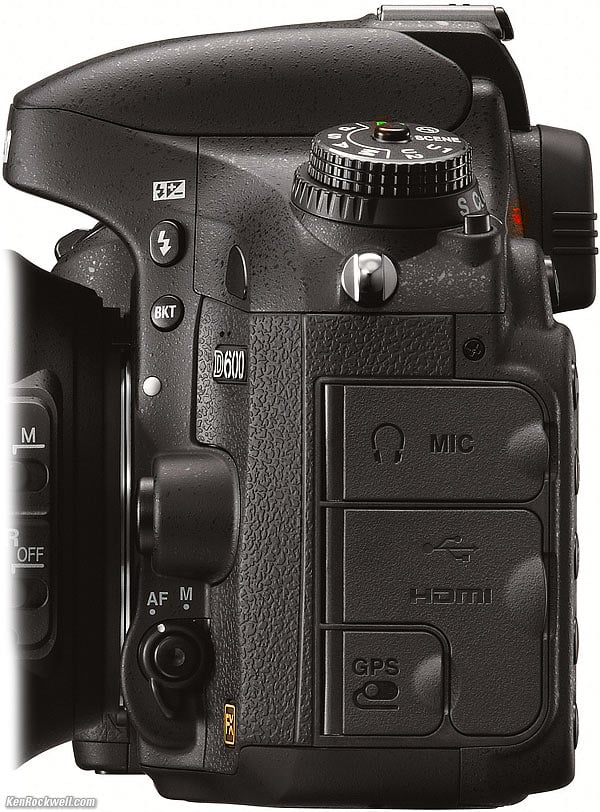
One side, Nikon D600.
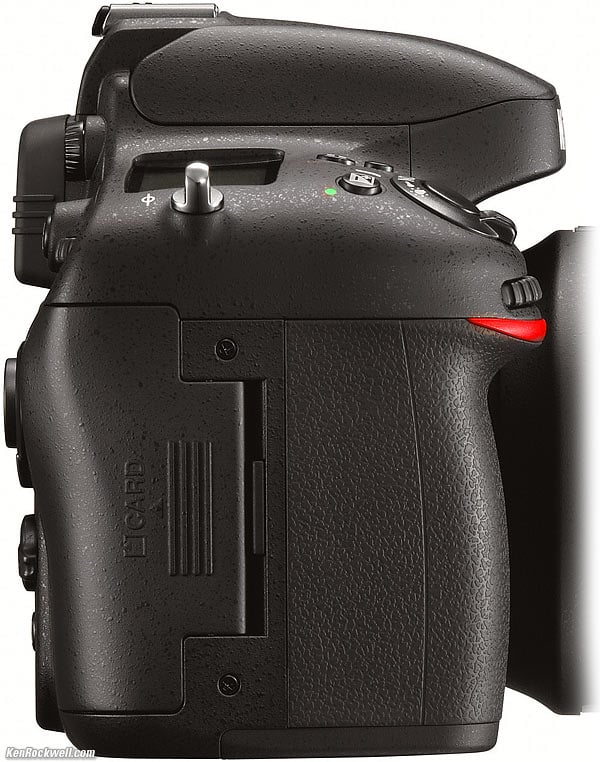
The other side, Nikon D600.
Introduction Lenses Missing Specifications Accessories
Performance Compared Usage Recommendations More
See my separate Nikon D600 Specifications page.
Introduction Lenses Missing Specifications Accessories
Performance Compared Usage Recommendations More
See my separate Nikon D600 Accessories page.
Performance top
Introduction Lenses Missing Specifications Accessories
Performance Compared Usage Recommendations More
Image: Sharpness Aliasing Color High ISOs Meter
Finder Autofocus Ergonomics U1 & U2 Shutter
Program Mode Flash Exposure Built-in Flash
Sunset. D600 at ISO 100, 50/1.4 G, f/13 at 1/640, VIVID +3 saturation, 6 sharpening, AUTO A4 white balance. Camera-original © BASIC LARGE JPG file.
Holy cow! Notice how there's no "digital ring" around the sun! The D600, in AUTO ADR, has enough highlight range to handle this well. I always use AUTO ADR, which should be the default, but sadly isn't. Set this at MENU > SHOOTING > Active D-Lighting > AUTO.
Let's look at just one percent of the image. I'll mark the area I'm going to enlarge in red:
The red box marks about 1% of the image area.
And here's what's in that red box at 100% magnification, no extra sharpening added to the LARGE BASIC JPG from the camera. If this is 6" wide on your screen, the complete image would print at 40 x 60 inches (over 1 x 1.5 meters) at this same magnification. Camera-original © BASIC LARGE JPG file.
Image performance top
Overall
The D600 is extraordinary, especially since 24MP is the optimum resolution for FX.
Sharpness performance top
Duh, with 24 megapixels, if you know what you're doing, you have more pixels than you'll ever need for anything.
Here are some typical hand-held snapshots:
Inside-Out Water Meter Cover. (Nikon D600, Nikon 55mm f/2.8 AF MICRO-NIKKOR, program auto gave f/9 at 1/320 at Auto ISO 100, AUTO white balance with A4 M1 trim, VIVID Picture Control with +3 Saturation, 6 sharpening. Camera-original © LARGE BASIC JPG file.
Fabric at 24 Megapixels. (Nikon D600, Nikon 55mm f/2.8 AF MICRO-NIKKOR, program auto gave f/8 at 1/250 at Auto ISO 100, AUTO white balance with A4 M1 trim, VIVID Picture Control with +3 Saturation, 6 sharpening. Camera-original © LARGE BASIC JPG file.
How sharp is the D600 set down to its 6 Megapixel (SMALL) setting? Let's see:
Fabric at 6 Megapixels. (Nikon D600, Nikon 55mm f/2.8 AF MICRO-NIKKOR, program auto gave f/9 at 1/320 at Auto ISO 100, AUTO white balance with A4 M1 trim, VIVID Picture Control with +3 Saturation, 6 sharpening. Camera-original © SMALL BASIC JPG file.
These are sharper than most people will get, but this is a review of what the D600 can do, not lenses or technique. You probably won't get this level of sharpness with junky lenses like Sigma or Tamron (Tokina can be pretty good), and you probably won't get it with zooms (even the 24-70 AFS isn't this sharp in the corners), and you won't get it unless your subjects are flat like these. The D600 is sharper than most people will ever be able to get out of it unless you're using a macro lens and shooting flat (boring) subjects.
I love the fact that even old classic lenses give stellar results on my D600, even better than the soft sample Nikon shares made with other lenses. Here's how it looks with my old 35-70/2.8D:
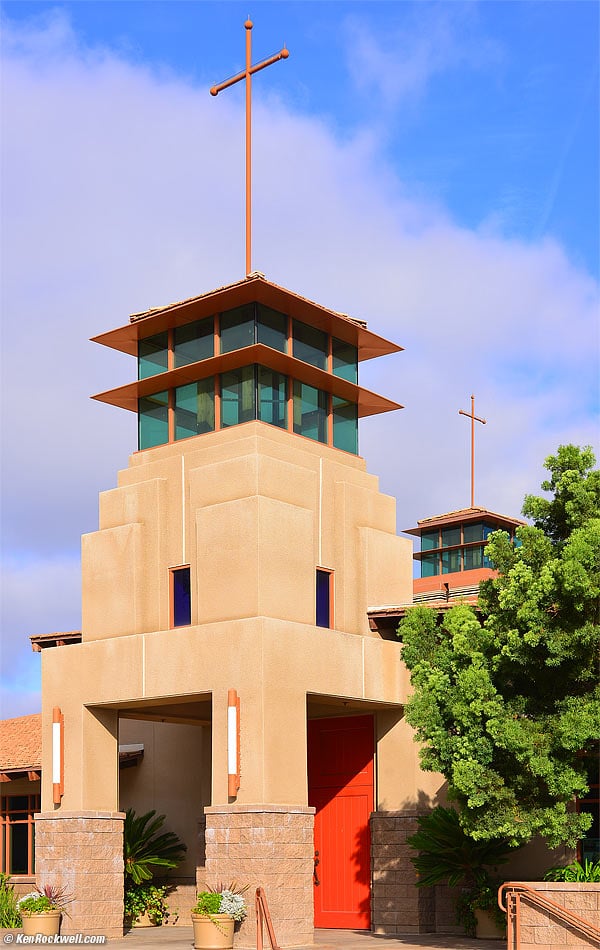 Sharp? (Nikon D600, Nikon 35-70mm f/2.8 AF-D at 52mm, program auto gave f/9 at 1/320 at Auto ISO 100, AUTO white balance with A4 M1 trim, VIVID Picture Control with +3 Saturation, 6 sharpening. Camera-original © LARGE BASIC JPG file.
Sharp? (Nikon D600, Nikon 35-70mm f/2.8 AF-D at 52mm, program auto gave f/9 at 1/320 at Auto ISO 100, AUTO white balance with A4 M1 trim, VIVID Picture Control with +3 Saturation, 6 sharpening. Camera-original © LARGE BASIC JPG file.
Aliasing performance top
With a sharp enough lens and a repeating line pattern at just the wrong spatial frequency, the D600 can get some minor aliasing.
This is good, it means that the D600 is as sharp as one wants it to be, similar to the D800E.
Fabric-Covered Skylights. (D600, 24-70/2.8 G at 24mm, f/5 at 1/100 at ISO 100.)
Area shown in red enlarged to 100% from original 24MP image. The colored bands are an artifact called aliasing.
You really have to go out of your way to make this happen, and it shows us how sharp is the D600 and the 24-70/2.8 G. You'll only see these colored bands one time in ten thousand, but you will see the added sharpness in all your shots.
This shows us that there's no need for a D600E without an anti-alias filter; the anti-alias filter of the D600 is pretty mild as it is.
Color performance top
Green. D600, 24-70/2.8 G at 55mm, f/3.2 at 1/60, ISO 100, VIVID Picture Control, +3 Saturation, 6 Sharpening, AUTO WB with A4 and M1 trim. original file.
While it's easy to create bold colors with the D600, for more subtle use, the D600 has the same slight green-shift problem as the D4, D800 and D800E.
The playback LCD is a tiny bit yellow, and I suspect that will go away with use. It's not enough to worry about.
Worse is that the image itself is a tad too green! No worries, so long as you tweak the white balance a little by setting:
MENU > SHOOTING > White Balance > AUTO > right click to AUTO Normal > right click to the rainbow chart > click one down to M1 > OK.
Set M1, and the green goes away and the LCD looks fine. My biggest whines about this is that we ought not have to tweak it to get neutral color, and when we do tweak it, exactly like the other 2012 FX Nikons, the jump between M0 and M1 isn't fine enough to let me dial-out the green exactly how I'd like it dialed out.
This is shooting JPG; you NEF shooters I'm sure will see something different.
Thank goodness, the D600's Picture Controls match other Nikons. If you have favorite settings, set the D600 that way, and you're done.
High ISOs performance top
ISO 320: Door. D600, 35-70/2.8D at 40mm, f/2.8 at 1/40 hand-held at ISO 320, Auto white balance with A4 M1 trim, VIVID Picture Control with +3 Saturation, 6 sharpening. Original © BASIC LARGE JPG file.
ISO 2,500-5,000: Look at my art! Nikon D600, Nikon 35-70mm f/2.8 AF-D, program auto gave f/2.8 at 1/125 at Auto ISO 2,500, AUTO white balance with A4 M1 trim, STANDARD Picture Control with +1 Saturation, 6 sharpening, about one-stop dodging on face for equivalent of ISO 5,000. bigger.
ISO 6,400: Fountain after dark. Hand-held at 1/6 of a second, 24-70/2.8G at 24mm and f/2.8, VIVID Picture Control, +3 saturation, 6 sharpening, 2,630K while balance, normal High ISO NR. Original © BASIC LARGE JPG file. Note: Very little is in focus, and there's a light just outside the top right of the frame adding flare.
High ISOs err on the side of being too sharp and detailed, which also shows the noise above ISO 6,400.
I prefer to set High ISO Noise Reduction to HIGH to reduce the noise at crazy ISOs like ISO 12,800 (MENU > SHOOTING > High ISO NR > High) for people shots, and I leave it alone for other shots like the dark fountain above.
ISO 12,800: Ryan at the beach 23 minutes after sunset. (Nikon D600, built-in flash, Nikon 35-70mm f/3.3-4.5 AF at 38mm, Auto ISO 12,800, f/8 at 1/125, STANDARD Picture Control with +1 Saturation, 6 sharpening, HIGH HI ISO noise reduction, Auto White Balance with A4 M1 trim.) Camera-original © SMALL BASIC JPG, -1/3 stop exposure compensation.
Katie can't really use chopsticks; I'm not sure from where this picture came. Nikon D600, Nikon 24-50mm f/3.3-4.5D at 50mm, program auto gave f/4.5 at 1/40 at Auto ISO 12,800, HIGH Hi ISO noise reduction, AUTO white balance with A4 M1 trim, STANDARD Picture Control with +1 Saturation, 6 sharpening. bigger. Original © SMALL BASIC JPG file.
Exposure Meter performance top
Hallelujah, it seems right-on in all conditions, which is better than many Nikon DSLRs which often need exposure compensation under some conditions.
The D600 has the best meter of any digital camera I've ever used; it's almost always dead-on.
Flash Exposure performance top
As expected, Nikon's flash exposures are perfect, even with the built-in flash. See the beach shot above? The built-in balances perfectly with natural light in the dark, or in sunlight:
Off to school, 26 September 2012. (Nikon D600, Nikon 55mm f/2.8 AF MICRO-NIKKOR, program auto gave f/8 at 1/200 at Auto ISO 100, built-in pop-up flash, AUTO white balance with A4 M1 trim, STANDARD Picture Control with +1 Saturation, 6 sharpening.) bigger. original © SMALL BASIC JPG file, after lossless rotation in iView MediaPro 3.1.3.
Katie at Lunch Bunch, 26 September 2012. (Nikon D600, Nikon 55mm f/2.8 AF MICRO-NIKKOR, program auto gave f/4 at 1/125 at Auto ISO 720, built-in pop-up flash, AUTO white balance with A4 M1 trim, STANDARD Picture Control with +1 Saturation, 6 sharpening.) bigger. original © SMALL BASIC JPG file, after lossless rotation in iView MediaPro 3.1.3.
Built-in Flash performance top
I've already covered that the built-in flash's exposure is dead-on.
The built-in flash recycles fast enough that it rarely slows me down, which is superb.
The built-in flash also works great up close.
The built-in flash also surprisingly has plenty of range. I seem to be able to get twenty feet (6 meters) away in daylight and it still has enough power for perfect fill-flash.
I'm impressed; this built-in may be good enough to eliminate the need for an SB-400, saving even more weight. The only real reason for an external flash is for more range and faster repeated recycling time, and the D600's built-in flash seems to be quite capable.
Autofocus performance top
AF is fast and accurate, except that all the sensors are pretty much all in the center of the image.
Very good (better than the Canon 5D Mark III) is that when set to Auto AF Area Select, the D600 does a great job of guessing where my subject's closest eyeball is. The Auto Selection is as clairvoyant as the D600's bigger brothers the D800 and D4.
The only thing I've noticed is that in lower light the D600's AF system can stall, but other AF systems do the same thing in the dark. The D600 has a very good built-in illuminator to help it in the dark, but it seems only to work if the central AF point is selected.
Once AF locks, you can't move the selected AF sensor.
Ergonomics performance top
Ergonomics are the most important aspect of camera performance. Good ergonomics, or how the camera handles, is the difference between getting the shot and losing it.
The D600 excels because the only other Nikon DSLR with ergonomics as good are the D600's little DX brother, the D7000. Every other Nikon DSLR is inferior to the D600's handling.
Much of why the D600's ergonomics are so good is because we can save and recall two complete sets of camera states with the U1 and U2 modes. While every other Nikon DSLR other than the D600 and D7000 require way too many menu tweaks to reconfigure the camera from one kind of shoot to another, once we set-up the D600 or D7000 as we want it, we always can get back to it with just one dial click.
The D7000's mode dial is free-spinning, while the D600's has a lock button. I dislike the lock button; it requires a little bit too much effort to release, and usually takes two fingers: one to press the button, and another to spin the dial. The Canon 5D Mark III's mode dial lock is much better; it can be released and the dial rotated with just one finger.
The Depth-of-Field Preview button can be hard to press unless you have fingers small enough to fit between your lens and the D600's grip.
Better than the D800, only very rarely has the Live View button gotten knocked by accident to activate Live View by accident.
For my big American hands, the grip is only about 85% as big as I'd like.
The dials are perfect: the perfect blend between firmness and grippy rubberyness. The D600's dials are much better than the $6,800 Canon 1D X' dials!
Leaving the Fn button set to Image Area, it's easy to get instant "digital zoom" by selecting the DX crop as you need it.
Playback performance top
The play button is on the wrong side. It requires a second hand to hit the Play button, and worse, requires the second (left) hand to zoom in and out.
Today, I can control all the playback and zooming and scrolling of the Canon 5D Mark III while I hold it in one hand, while with the D600, I need two hands. I don't always have two hands, so this is my biggest complaint along with the green color shift.
LCD
The LCD is reasonably accurate; images seem too yellow-green because they usually are! My brand-new LCD is a tiny bit yellow, not enough to worry about on its own, and I suspect it will correct itself with age. The real problem is tweaking out the extra green in the image itself as I mentioned at Color.
The LCD lies behind an uncoated plastic screen, off of which reflections can distract. The Canon 5D Mark III has a much better LCD than any of today's Nikons.
There is no Auto Brightness Control, which is just as well because the auto brightness control of the D800 doesn't work well enough to use anyway.
The fixed brightness is a bit limiting in direct sunlight.
U1 and U2 Instant Recall Modes!!! performance top

New: Locking U1 and U2 positions!
The D600's U1 and U2 positions finally address my biggest beef with the D800, which was the lack of any fast way to save and recall complete banks of camera settings.
With all my other older Nikons, it takes too long to reset a camera to go from people to landscape photography, so I keep one camera for each kind of shooting. With the D600, I now have two cameras in one, each recalled in the flick of the dial.
Gone are the D800's and D4's two sets of four stupid settings banks, which took as long to select as not having them at all, and they never locked or could be saved anyway. Good riddance to bad rubbish!
The U1 and U2 modes are easy to set in MENU > SETUP > Save user settings > (save to U1 or U2) > Save settings, and the camera's settings are burnt into that spot on the dial.
My autofocus settings, white balance and trims, exposure compensations, exposure modes, AUTO ISO minimum shutter speed and maximum ISO settings, flash modes and everything else I want in each setting follow along, and instantly recall as I set either on the dial. There's no way I could reset all these things in the field one by one as I shift between different kinds of subjects if I didn't have these U1 and U2 modes.
I set U1 for nature and landscape shots, and U2 for family and people photos.
Better than Canon's C1, C2 and C3 positions on their mode dials, Nikon's U1 and U2 settings save whatever tweaks you make to them, even if you turn off the power, and don't reset to your personally preset defaults until you switch away to a different setting and return! Yay! This way if I have to tweak a white balance it stays that way for the duration, and next time I select U1 or U2, I'm back at my personal defaults. I love it!
If you want to make a permanent change to either of these settings, simply make the changes while in the U1 or U2 position, and then MENU > SETUP > Save user settings > (select U1 or U2) and you're done.
Finder performance top
The viewfinder is wonderful, big and sharp and clear.
It's optimized for lenses of f/2.2; using faster lenses won't make the finder any brighter or show you the narrower depth-of-field of faster lenses, and slower lenses will look darker. Since the D600 is optimized for slightly faster lenses than most modern Nikon finders optimized for f/2.5 lenses, the D600 may be a tad darker with slower lenses, and show defocus effects better for faster lenses than other cameras.
When you've selected DX mode, the finder shows a black hairline to mark the active part of the finder. It doesn't go a darker gray as do more expensive FX cameras. I use the DX mode as a "digital zoom;" it's foolish to pay for a D600 and only use it with DX lenses.
Don't worry that it's only rated as "97% coverage;" it works the same as a 100% finder. Nikon merely masks off a fraction of a millimeter more on each side just to try to scare innocent people into buying more expensive cameras. If anything's critical, use Live View, but I never have.
Shutter performance top
The D600's shutter is quiet and smooth. It's a bit quieter than the D800 and much quieter than the D4. There is very little mechanical vibration and the shutter's "trigger pull" is completely smooth, unlike the ratchety pull of the LEICA M9.
The quiet mode is a pain; it's a bit quieter, but significantly slower and the finder goes black until you release your finger and the cycle completes for each shot. You most certainly can't shoot in Continuous mode at the same time as Quiet mode.
If you want a good quiet mode that's both fast and quiet and can shoot sequences with one long press, get a Canon 5D Mark III.
Program Mode performance top
The D600 selects different combinations of f/stops and shutter speeds depending on the focal length.
It selects smaller apertures with wide lenses, and faster shutter speeds with longer lenses.
Data performance top
JPG files are just the right size. I love it!
It seems Nikon might have a new JPG encoding engine; file sizes seem to vary much more based on image complexity than they have in the past. That's good; it means the camera is using data more efficiently.
Default DPI is 300, as Nikons have always been. I prefer 72 DPI to save me a step in Photoshop CS6 when dropping-in text, but that's just me.
I shoot in JPG BASIC, with JPG compression left in its default Size Priority mode.
For family and general shots, I shoot in the 6 megapixel mode, which is SMALL JPG BASIC, and these files have a median size of a compact 650 kB.
For nature and landscapes, I shoot 24 MP LARGE BASIC JPGs, which are also a convenient median size of about 3 MB.
BASIC JPGs, if scrutinized at 100% on a computer, may have very slight artifacts that will never be visible in print. If you're more of a tweaker than a shooter, set MENU > SHOOTING > JPEG Compression > Optimal Quality, which will increase files size when needed to keep artifacts to a minimum.
When pointed straight down, sometimes the D600 will set a vertical rotation flag.
Batteries and Power performance top
The D600 takes the same EN-EL15 battery as the D7000 and D800.
As expected, I get about 1,200 shots per charge, and that's even with using the built-in flash now and then.
Movies performance top
Video files look great, even in dim light — if you can get them in focus.
The Live View LCD is loaded with all sorts of annoying overlays.
The D600 only shoots in 16:9; there are no 4:3 modes.
Autofocus has problems for casual family use. It's not very fast, and unless you want to use a separate off-camera microphone, you may hear the lens quietly trying to autofocus. It's pretty slow when activated with a half-press of the shutter button.
The D600's continuous AF-F autofocus mode works as well as any DSLR, especially the Canon T4i with STM lenses, but it's still far slower than our eyes.
Worse, unless the subject stays in the same place (which means it's not moving), the D600's video AF area can't be moved around the frame fast enough to track my kids running around.
AF is at only one point at a time, and it's very slow trying to move the AF point around with your subjects.
The face-ID AF-F mode is the best for home movies. It does a fair job of finding faces, and then sometimes being able to focus on them.
Unlike a real camcorder, compact digital camera, iPhone, iPad or iPod touch that have everything in focus in their videos, the huge sensor of the D600 that gives it such great color and clean images in any light also means that very little is ever in focus.
All DSLRs have very shallow depths-of-field, and so only one thing is usually in focus. If your subject is in focus, your background won't be. If focus is off even a little, it will be obvious. This is why DSLRs still can't autofocus as well as we need.
If you turn the playback audio level too high, it will distort. That's OK because your recording is OK; if you're getting distortion, try not playing it so loud.
The D600 and the Canon T4i area as good as it gets, but for great results you either have to be patient, or focus manually. Good luck!
Sample Movie Files performance top
These are files direct from my D600 and 24-70/2.8 G. The occasional light clicking heard is the lens trying to focus in AF-F mode. These were in auto exposure, somewhere around f/3.5 at ISO 500 as the camera chose.
The Dog Train (17 second 1080/29.97p, 29MB file. VIVID Picture Control with +3 Saturation, AUTO WB with A4 M1 trim.)
Toby Chases the Pumpkin (24 second 720/25p, 25 MB file. NORMAL quality, STANDARD Picture Control with +1 Saturation, AUTO WB with A4 M1 trim.)
Toby Kisses Ryan (15 second 720/25p 16 MB file. NORMAL quality, STANDARD Picture Control with +1 Saturation, AUTO WB with A4 M1 trim.)
Note: these are smooth videos. If they seem jumpy, that's because your computer is choking on the data.
These aren't in very good focus. They have no noise and do have bright colors, even shot inside without lights, which is all what I'm trying to show. The images look great, but autofocus still has a heck of a time with large-sensor cameras.
Compared top
Introduction Lenses Missing Specifications Accessories
Performance Compared Usage Recommendations More
NEW: LEICA M240, LEICA M9, Fuji X100S and Nikon D600 Image Quality Comparison 11 March 2014
The biggest things I see compared to the Nikon D800 are smaller size, optimum resolution (D800 has too much!), a smaller sea of AF sensors, faster frame rate, less weight, and a much lower price.
The biggest downside to the D600 compared to the others is that the size of the region seen by the sea of AF sensors is smaller in the D600. Nikon is using essentially the same DX-sized AF detector in the FX D600 as the DX D7000, so in the D600, all the sensors really only cover a much smaller area in the center of the frame. Personally, I always seem to need to focus on something just outside the area covered by AF sensors with my existing cameras, so the D600 will bug me more. So what? Half the time all I use is the center sensor anyway.
Unless I discover something seriously missing when my own D600 arrives, I will no longer be recommending the D800 and D800E for anything other than testing lenses. The D800 and D800E are a pain to use in the field for their lack of programmable presets, and cost too much.
I doubt there will be any disappointments; even Nikon's cheapest D3200 is a wonderful camera with nothing left out.
| Announced | 9/2010 |
9/2012 |
2/2012 |
7/2008 |
| Format | ||||
| Resolution | 16 MP |
24 MP |
36 MP |
12 MP |
| Frame Rate | 6 FPS |
5.5 FPS |
4 FPS |
5 FPS |
| U1 & U2 Modes? | YES |
YES |
no |
no |
| AF settings easy save and recall? | YES |
YES |
no |
no |
| External AF Controls | Abbreviated |
Abbreviated |
Abbreviated |
Full |
| LCD | 3" 921k dots |
3.2" 921k dots |
3.2" 921k dots |
3" 920k dots |
| ISO normal | 100 ~ 6,400 |
100 ~ 6,400 |
100 ~ 6,400 |
200 ~ 6,400 |
| ISO with L- and H+ values | 100 ~ 25,600 |
50 ~ 25,600 |
50 ~ 25,600 |
100 ~ 25,600 |
| Battery | EN-EL15 |
EN-EL15 |
EN-EL15 |
EN-EL3e |
| Sync Speed | 1/250 |
1/200 |
1/250 |
1/250 |
| AF Points | 39 |
39 |
51 |
51 |
| Portion of frame served by AF points | small |
very small |
small |
small |
| Body toughness | consumer |
consumer |
semi-pro |
semi-pro |
| Weight w/ card and battery | 27.3 oz. 774g |
30.0 oz. 850 g. |
35.1 oz. 994 g. |
38.3 oz. 1,085 g. |
| Storage | SD + SD |
SD + SD |
CF + SD |
CF only |
| Price, 9/2012 |
For far more details tabulated, see my 2012 DSLR comparison.
Usage top
Introduction Lenses Missing Specifications Accessories
Performance Compared Usage Recommendations More
Overall
I'll have detailed online guides, but for now, see my Nikon D7000 guide, which is 95% the same thing.
Here is my personal setup file for my D600. Get it while you can, this is one of the few that doesn't have my name and address all over it.
This won't do anything online; you have to download it to a computer, copy it to a card, put the card in your D600, and hit:
MENU > Setup > Save/load settings > Load settings > OK
and your D600 will be setup exactly as mine is today.
You may want to save and archive your own settings first.
I use U1 for nature and landscape (high resolution, high color) and U2 for photos of my family (low resolution and moderate color).
Manual-Focus Lenses
With manual-focus (non-AF) lenses, you must set your D600's top dial either to "A" or "M" (Aperture-priority or Manual exposure mode).
In any other setting, like my favorite U1, U2 or P modes, the D600 will flash "F - -" and not work at all.
Recommendations top
Introduction Lenses Missing Specifications Accessories
Performance Compared Usage Recommendations More
Buy one, I did. This is Nikon's best digital camera ever.
As far as lenses are concerned, the kitted optional 24-85mm VR is an excellent lens, and you have your choice of any of Nikon's hundreds of other lenses made today and for more than 50 years if you prefer. Honestly, one of my all-time favorites is my 50mm f/1.8 AF-D that sells for $125! See Nikon Lenses and Nikon FX Lens Recommendations and follow their links for a ton of information and recommendations.
If you want a do-everything lens that's the direct FX replacement to the 18-200mm DX, get the 28-300mm VR. It could be the only FX lens you ever need, but it is bigger than I'd want to carry every day.
For flash, try the built-in before you go buying anything else. The built-in flash is much better than I expected. Only if it lacks range or recycling speed, or if I'm doing a lot of hard, rapid shooting, will I use my SB-400 flash. With digital's high ISOs, there's rarely any need for the big flashes like the SB-700 or SB-910.
If you've found the time, effort and expense I incur for you in researching and sharing all this for free, this free website's biggest source of support is when you use these links, especially this link to the body at Adorama, the kit with 24-85mm VR at Adorama (all the versions and accessories at Adorama), or this link to the kit at Amazon or body-only at B&H, when you get anything, regardless of the country in which you live.
Thanks!
Ken
More Information top
Introduction Lenses Missing Specifications Accessories
Performance Compared Usage Recommendations More
Nikon's D600 product information.
Help me help you top
I support my growing family through this website, as crazy as it might seem.
The biggest help is when you use any of these links when you get anything, regardless of the country in which you live. It costs you nothing, and is this site's, and thus my family's, biggest source of support. These places have the best prices and service, which is why I've used them since before this website existed. I recommend them all personally.
If you find this page as helpful as a book you might have had to buy or a workshop you may have had to take, feel free to help me continue helping everyone.
If you've gotten your gear through one of my links or helped otherwise, you're family. It's great people like you who allow me to keep adding to this site full-time. Thanks!
If you haven't helped yet, please do, and consider helping me with a gift of $5.00.
As this page is copyrighted and formally registered, it is unlawful to make copies, especially in the form of printouts for personal use. If you wish to make a printout for personal use, you are granted one-time permission only if you PayPal me $5.00 per printout or part thereof. Thank you!
Thanks for reading!
Mr. & Mrs. Ken Rockwell, Ryan and Katie.
Home Donate New Search Gallery Reviews How-To Books Links Workshops About Contact

